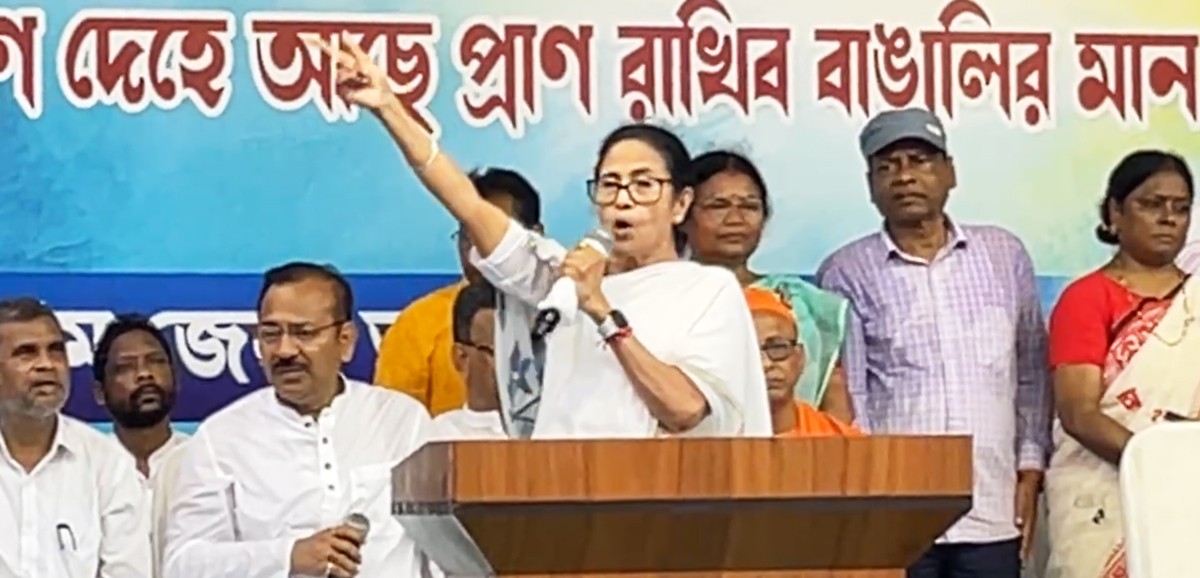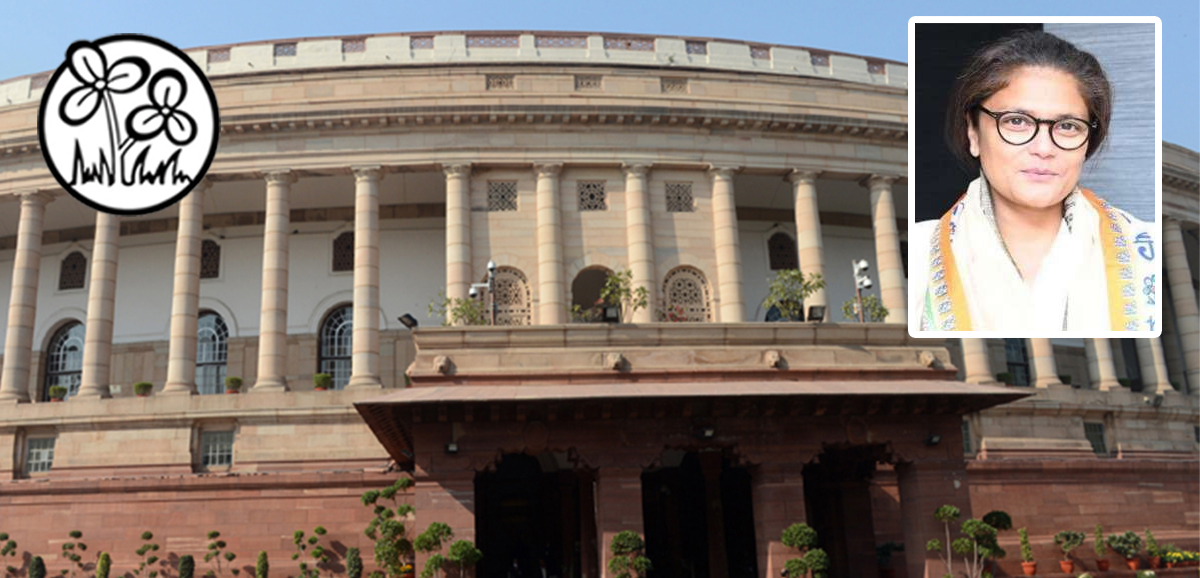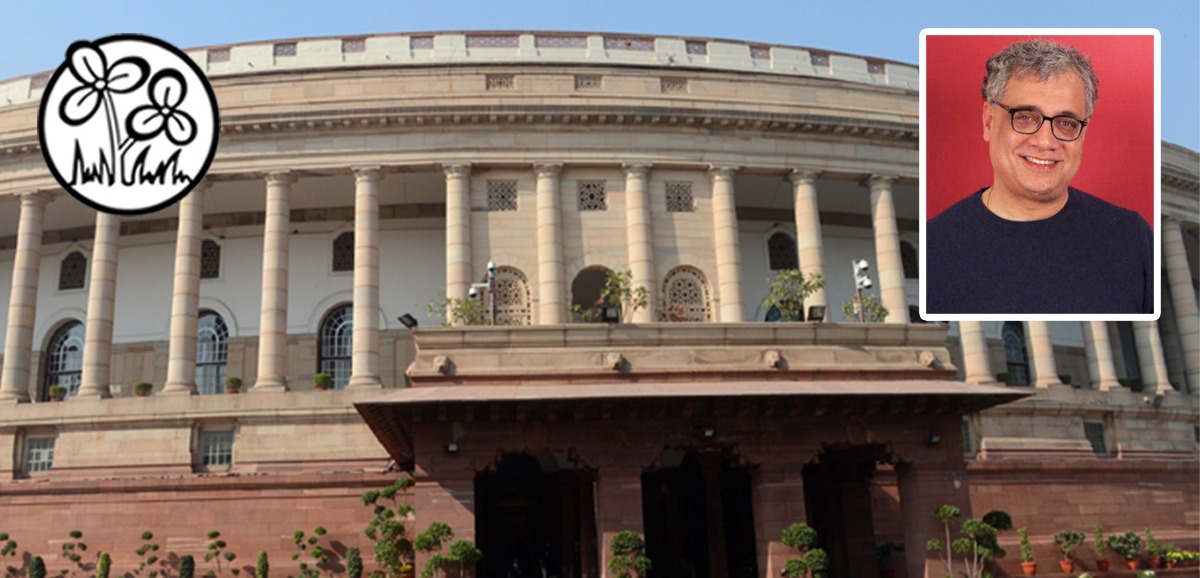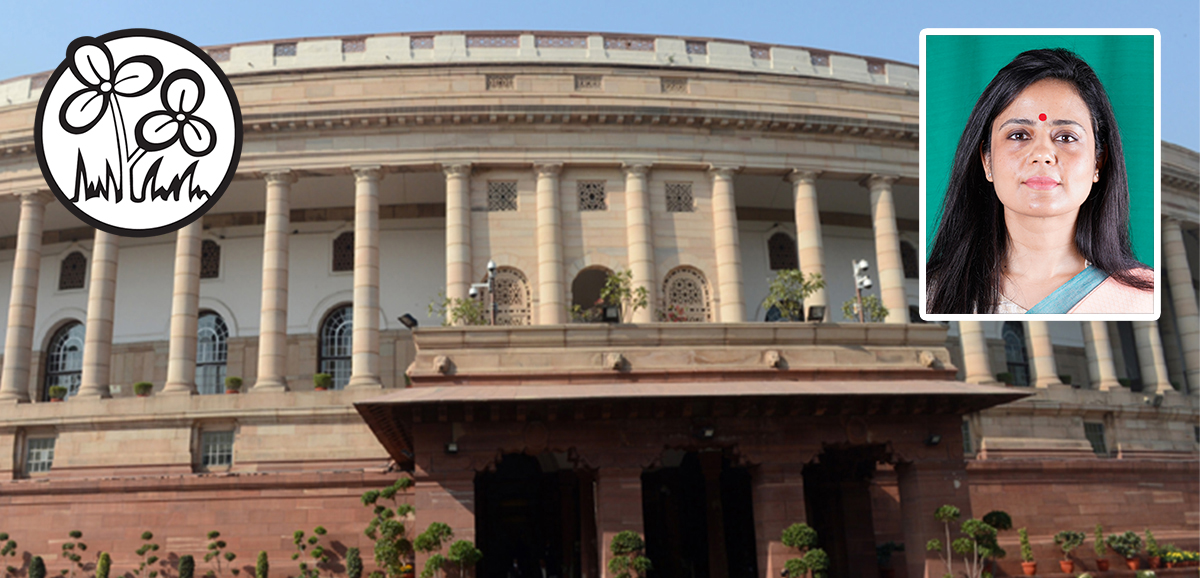পূর্ব বর্ধমানে মুখ্যমন্ত্রী আজ মমতা বন্দোপাধ্যায়ের বক্তব্য:
২০১১ সালের পর থেকে আমরা সারা রাজ্যে ২.২৬ লক্ষ গৃহ পাট্টা, ১.৮০ লক্ষ কৃষি পাট্টা এবং ৪৭ হাজারেরও বেশি বনজমি পাট্টা প্রদান করেছি। শুধুমাত্র পূর্ব বর্ধমানেই ২৮,৮৪০টি পাট্টা দেওয়া হয়েছে , ৮৩২টি শরণার্থী পাট্টা এবং ১,৪৪৩টি বনজমি পাট্টা। আগামী দিনে আরও ২৪,০০০ পাট্টা প্রদান করা হবে। বহু প্রকল্প ইতিমধ্যেই এখানে চালু রয়েছে
আমরা ঘর তৈরি করব। সমস্ত কাঁচা ঘর পাকা করা হবে। কেন্দ্রীয় সরকার MGNREGA, গ্রামীণ সড়ক যোজনা এবং জল স্বপ্ন প্রকল্পে অর্থ দেওয়া বন্ধ করেছে। আমরা আমাদের অংশের অর্থ দিচ্ছি। কেন্দ্র এসএসএম ও বাংলার বাড়ি প্রকল্পের অর্থও বন্ধ করে দিয়েছে। তা সত্ত্বেও আমরা ইতিমধ্যেই ৪৭ লক্ষ ঘর তৈরি করেছি এবং ১২ লক্ষ ঘরকে পাকা ঘরে রূপান্তরিত করার জন্য অর্থ প্রদান করেছি। বাকি ১৬ লক্ষ ঘর ডিসেম্বর মাসে প্রথম কিস্তি এবং জুন মাসে দ্বিতীয় কিস্তি পাবে
এ বছরের বর্ষায় বহু কাঁচা ঘর ভেঙে গেছে বা ভেসে গেছে। উদ্বিগ্ন হওয়ার কিছু নেই। আমি জেলাশাসকদের বলব ক্ষতিগ্রস্ত ঘরগুলির তালিকা তৈরি করে মুখ্যসচিবের কাছে পাঠাবেন। এই জন্য আমরা আলাদা একটি কর্মসূচি শুরু করব। এটি আমাদের নির্মীয়মাণ ২৮ লক্ষ ঘরের বাইরে আরেকটি অতিরিক্ত উদ্যোগ হবে
পশ্চিমবঙ্গ সারা ভারতে ধান উৎপাদনে প্রথম স্থান অর্জন করেছে। আমি সবার প্রতি, বিশেষ করে কৃষকদের অভিনন্দন জানাই। কেন্দ্রীয় সরকার MGNREGA প্রকল্পের অর্থ বন্ধ করে দিয়েছে কিন্তু আমি কর্মশ্রী প্রকল্প শুরু করেছি। এই প্রকল্পে ইতিমধ্যেই ৭৮ লক্ষ মানুষ জব কার্ড পেয়েছেন। আমরা রাজ্য কোষাগার থেকে ১৯,০০০ কোটি টাকা ব্যয় করে ৯১ কোটি কর্মদিবস সৃষ্টি করেছি
দেশের বিভিন্ন রাজ্যে বাংলার প্রায় ২২ লক্ষ পরিযায়ী শ্রমিক কাজ করছেন। তাঁরা কারও দয়ায় নয়, নিজেদের দক্ষতার জোরে কাজ পেয়েছেন। বহু ক্ষেত্রে তাঁদের দক্ষতা অসাধারণ। অথচ আজ তাঁরা নির্যাতন ও আক্রমণের শিকার হচ্ছেন। আমি জানতে পেরেছি, আজ বারাসাতের হাবরায় আমার এক ভাই মারা গেছেন, যাঁকে মুম্বাইয়ে মারধর করা হয়েছিল। এই রকম অসংখ্য ঘটনা ঘটছে
বাংলায় অন্যান্য রাজ্যের প্রায় ১.৫ কোটি পরিযায়ী শ্রমিক বসবাস করেন। আমরা তাঁদের নির্যাতন করি না, ভালোবাসি, আপন করে নিই। তাহলে কেন আমাদের শ্রমিকদের ওড়িশা, মুম্বই, গুরুগ্রাম ও গুজরাটে আক্রমণ করা হচ্ছে? আপনারা কি বাংলার মানুষকে মানুষ বলে মনে করেন না? সারা বিশ্ব আমাদের প্রতিভাকে সম্মান করে। মনে রাখবেন ট্রাম্প গুজরাটিদের হাতকড়া পরিয়ে মার্কিন যুক্তরাষ্ট্র থেকে তাড়িয়ে দিয়েছিল, কিন্তু বাঙালিদের তাড়াতে পারেনি
আমি বাংলার পরিযায়ী শ্রমিকদের বাংলায় ফিরে আসতে বলব। আমি তাঁদের জন্য একটি প্রকল্প তৈরি করেছি। তাঁরা বাংলায় ফিরে এলে যাতায়াত খরচ বাবদ সঙ্গে সঙ্গে ৫,০০০ টাকা পাবেন। রেজিস্ট্রেশন করার জন্য একটি পোর্টাল চালু হয়েছে। এছাড়াও তাঁরা ‘আমাদের পাড়া আমাদের সমাধান’ ক্যাম্পে অথবা বিডিও অফিসে নাম নথিভুক্ত করতে পারেন। সেখান থেকে জেলা শাসক ও পুলিশ সুপারের কাছে নাম যাবে। আইসিরাও এসপির কাছে নাম পাঠাতে পারেন। এই ৫,০০০ টাকার পাশাপাশি তাঁরা প্রতি মাসে আরও ৫,০০০ টাকা এক বছরের জন্য পাবেন, যতদিন না তাঁরা আর্থিকভাবে স্থিতিশীল হবেন। তাঁদের খাদ্য সাথী ও স্বাস্থ্যসাথীর সুবিধা দেওয়া হবে। সন্তানদের শিক্ষার খরচও তাঁদের দিতে হবে না, সেগুলো সব আমরা নিশ্চিত করব। মনে রাখবেন, আমরা মরে যাইনি, আমরা যতদিন বেঁচে আছি, ততদিন তাঁদের ভবিষ্যৎ আমরা নষ্ট হতে দেব না। তাঁদের দক্ষতার প্রশিক্ষণ দিয়ে কর্মশ্রী প্রকল্পের মাধ্যমে চাকরির ব্যবস্থা করা হবে। প্রত্যেককে তাঁদের দক্ষতা অনুযায়ী কাজ দেওয়া হবে। ব্যবসার জন্য ঋণও নেওয়া যাবে। কোনো কাজ কিন্তু ছোট নয়। এই প্রকল্পের নাম ‘শ্রমশ্রী’
কন্যাশ্রী আমাদের অন্যতম বৃহৎ প্রকল্প, যা আন্তর্জাতিক স্বীকৃতি পেয়েছে। ওবিসি আসন সংরক্ষণের বিষয়ে আমরা সাধারণ শ্রেণির কোটার ক্ষেত্রেও কোনো কাটছাঁট করিনি। এর জন্য আলাদা তহবিল রয়েছে যাতে সাধারণ শ্রেণির ছাত্রছাত্রীরা কোনো সমস্যার মুখে না পড়ে
আমাদের শাসনকালে গ্রামীণ এলাকায় ৭৬% এবং শহরাঞ্চলে ৭৮% পানীয় জল সরবরাহ নিশ্চিত করা হয়েছে। এর জন্য আমরা ৩৮,০০০ কোটিরও বেশি টাকা ব্যয় করেছি। আমরা জমি বিনামূল্যে দিয়েছি এবং এই পরিষেবার রক্ষণাবেক্ষণও করছি। এখনও আরও ৬৫,০০০ কোটি টাকা প্রয়োজন। কেন্দ্র এখান থেকে কর আদায় করে কিন্তু আমাদের অর্থ ফেরত দেয় না। বর্তমানে জিএসটি ছাড়া আর কোনো কর নেই। পাঁচটি প্রকল্পের অর্থও বন্ধ করে দেওয়া হয়েছে, অথচ আমরা সেগুলোও চালাচ্ছি
আমরা বলেছিলাম যে স্বাস্থ্য বীমার উপর থেকে জিএসটি তুলে দেওয়া উচিত এবং বীমা সংস্থাগুলি যেন তাদের প্রিমিয়াম না বাড়ায়। এর ফলে আমরা ৯০০ কোটি টাকার রাজস্ব ক্ষতির মুখে পড়েছি
আমি প্রধানমন্ত্রীর থেকে এমনটা আশা করি না। আমি তাঁর চেয়ারের সম্মান করি, কিন্তু তাঁকেও আমাদের চেয়ারকে সম্মান করতে হবে। তিনি কেন বলবেন, “বাংলায় চোর আছে তাই আমি টাকা বন্ধ করেছি”? উত্তরপ্রদেশই সবচেয়ে বড় চোর। মহারাষ্ট্র আর বিহার, এই ডবল ইঞ্জিন রাজ্যগুলোও সবচেয়ে বড় চোর। বাংলাকে বদনাম করতে কতগুলো দল পাঠিয়েছে জানেন? ১৮৬টি দল! ভাবা যায়?
– সব গ্রাম পঞ্চায়েত আমাদের দখলে নেই। অনেক দল আছে। পঞ্চায়েতগুলো কখনও একটি দলের হতে পারে না, যেমন লোকসভা আর বিধানসভায় বিভিন্ন দলের প্রতিনিধি থাকে। গণতন্ত্রে বিভিন্ন দল থাকবে। কেন্দ্র কিছু সমস্যার কথা জানিয়ে তারা আমাদের কাছে জবাব চেয়েছিল। আমরা প্রতিটি প্রশ্নের উত্তর দিয়েছি। তবুও যদি একজন ছাত্র সব প্রশ্নের উত্তর দেওয়ার পর শূন্য পায়, সে কি মেনে নেবে? আপনি চোর আর দেশদ্রোহীদের সঙ্গে বৈঠক করছেন আর বাংলাকে দোষারোপ করছেন। এতে কি আপনার লজ্জা হয় না? আসলে তারা নির্লজ্জ
ভোটের আগে আপনি পরিযায়ী পাখির মতো আসছেন। আমি চাই আপনি বছরের ৩৬৫ দিন আসুন, কারণ আপনার ফ্লাইট, খাবার আর থাকার খরচ সম্পূর্ণ বিনামূল্যে। তবে মনে রাখবেন, আমি রাজ্যের তহবিল থেকে কিছু নিই না। আমি সাতবার সাংসদ ছিলাম, গত ১৪ বছরে ২.৫ লক্ষ টাকারও বেশি পেনশন নিতে পারতাম, কিন্তু আমি এক পয়সাও নিইনি। কেউ সেটা মনে রাখে না। মুখ্যসচিব এখানে আছেন, আমি যখন কোনও সার্কিট হাউসে থাকি তার সম্পূর্ণ খরচ নিজে দিই। আমি বই লেখার রয়্যালটি দিয়ে নিজের খরচ চালাই। আমার টাকা চাই না, আমি প্রতিভা আর আত্মসম্মান চাই
বাংলাকে অসম্মান করলে আমি কষ্ট পায়, কারণ সেটা আমায় ব্যথা দেয়। আমায় যত খুশি গালাগালি দিন, বদনাম করুন, কিন্তু মনে রাখবেন আমি লড়তে জানি। আমার সাহস আছে। এটা আমার মাটির শক্তি। আমায় ভয় দেখতে পারবেন না
ভোটের সময় এলেই ওরা এনআরসি নিয়ে আসে, ভোটার তালিকা থেকে নাম কেটে দেওয়ার চেষ্টা করে। আমি নির্বাচন কমিশনকে সম্মান করি, কিন্তু অনুরোধ করব বিজেপির ললিপপ হবেন না। যদি এটা করেন, দেশের মানুষ ক্ষমা করবে না। ওরা বলে বাংলায় বাংলাদেশি আছে। আমি একটা ছোট প্রশ্ন করেছিলাম এবং পরিচালক গৌতম ঘোষের সোশ্যাল মিডিয়া পোস্টে তার উত্তর পেয়েছি। তখন তো আমরা জন্মাইনি, আর এখন আমাদের দোষ দিচ্ছে
১৯৪৭ সালে স্বাধীনতার পর, দেশভাগের সময় আপনারা কী করেছিলেন? ভারতবর্ষকে ভাগ করার সময় বাংলাকে ভাগ করেছেন, পাঞ্জাবকেও ভাগ করেছেন। আন্দামানের সেলুলার জেলে ৭০০-র বেশি বাঙালি বন্দী ছিলেন। স্বাধীনতা সংগ্রামে ৯০% বাঙালি, ১০% পাঞ্জাবি ছিলেন। আপনারা জানতেন বাংলাকে দমন করা যাবে না, তাই বাংলাকে আর পাঞ্জাবকে ভাগ করেছিলেন। পাকিস্তানে আজও একটা পাঞ্জাব আছে। বাংলাদেশের অস্তিত্ব আমরা তৈরি করিনি, সেটা আপনারা আর আপনার পূর্বপুরুষেরা করেছেন। ভাষা যদি একই হয়, আমরা কী করতে পারি? বাংলা একটি আন্তর্জাতিক ভাষা
আজ যদি মানুষ বাংলায় কথা বলে, তাদের হোটেলে জায়গা দেওয়া হয় না, কাজ দেওয়া হয় না, পড়াশোনার সুযোগ দেওয়া হয় না। আমরা বাংলায় কথা বলব। আমরা অন্য ভাষাতেও কথা বলব, কারণ আমরা তাদের সম্মান করি। কিন্তু আমি কেন বাংলায় কথা বলব না? আপনাদের মাথা কি পুরোপুরি মরুভূমিতে পরিণত হয়েছে? ওরা বাংলাকে সহ্য করতে পারে না। দুটি জাতীয় সঙ্গীতই বাংলায় লেখা—ভারতেরও, বাংলাদেশেরও। বাংলার ইতিহাস ভুলবেন না
বাংলার মধ্যে একই ভাষায় একাধিক উপভাষা রয়েছে। রাজা রামমোহন রায় সতীদাহ প্রথার কঠোর বিরোধিতা করেছিলেন। বাংলার মতো এমন সংস্কার আর কোথায় হয়েছে? আমরা বজ্রকণ্ঠে জয় বাংলা বলব। এটাই আমাদের স্লোগান। যতই আমাদের ঘৃণা করুন, ভাষার ওপর এই নির্যাতন আমরা মেনে নেব না। আজ ক্ষমতায় আছেন বলে এটা করছেন। কিন্তু যখন আর ক্ষমতায় থাকবেন না, তখন কী করবেন? মনে রাখবেন, নিজের ঘর থেকেই সবকিছু শুরু করতে হয়
আগে তারা বলত, মমতা বন্দ্যোপাধ্যায় বাংলায় দুর্গাপুজো করতে দেন না। এখন তারাই বলছে “জয় মা দুর্গা”। কেন? কারণ ভোট আসছে, তারা ভোট চায়। তারা নিজেরাই একটা মনগড়া হিন্দু ধর্ম শুরু করেছে এবং তারা এটা মানুষের ওপর চাপিয়ে দিতে চায়। এটা কোনোদিন হবে না, হাজার বছরেও না। আমরা মাথা নত করব না










